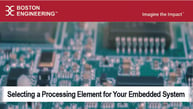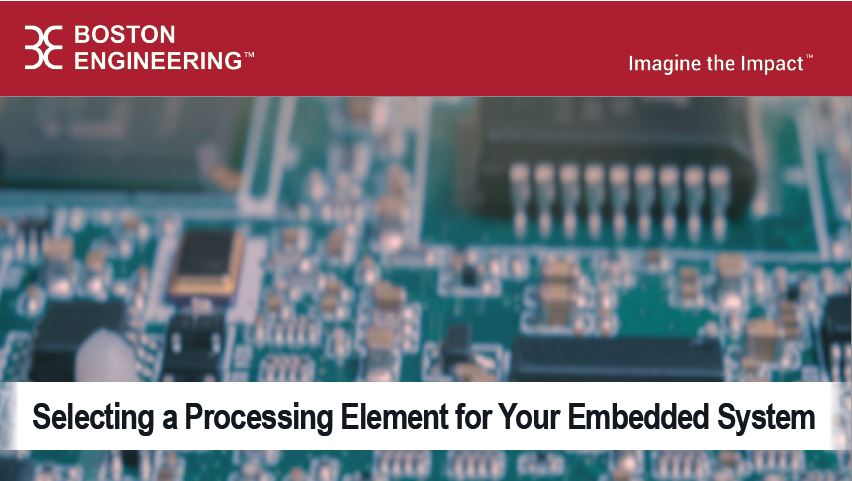Understand the Development and Sustaining Team(s) when Selecting a Processing Element for Your Embedded System
 This article is an excerpt from the Boston Engineering "Selecting a Processing Element for Your Embedded System" white paper. For a copy of the the complete publication, visit the Selecting a Processing Element for Your Embedded System download page.
This article is an excerpt from the Boston Engineering "Selecting a Processing Element for Your Embedded System" white paper. For a copy of the the complete publication, visit the Selecting a Processing Element for Your Embedded System download page.
2. Understand the Development and Sustaining Team(s):
The team selecting the processing element should have hardware and software representation. This is because both disciplines will spend a lot of time designing it in and writing firmware for it. The selection team should be supplemented with someone who knows the customers desires and sourcing or an engineer that is tasked with making sure the part can be sourced.
Software and firmware have become a larger portion of the embedded system development Non-Recurring Engineering (NRE) pie. One implication of this is that any advantage that can be given to the SW/FW team will often pay for itself. Increasing performance of MCU’s, Processors, and FPGA’s is one such advantage. Use this increased capability to give your SW team a solid OS, with a rich set of libraries and development tools to work with. Embedded Linux is popular for these reasons.
Leverage the development teams experience with processors and operating systems by including past successful devices in the trade. The team at Boston Engineering targets everything from bare metal RTOS and mainstream operating systems like Linux.
Choosing a processor family that is new to the development team may be necessary because of increased performance or specific peripherals and other capabilities but it does come at the cost of the team learning to program it. Running an operating system on the new hardware can reduce some of the learning curve if the OS abstracts the hardware to a level that the development team is used to working with.
Embrace the future trends that are shaping a new era of engineering excellence.
Boston Engineering is a multidisciplinary engineering consulting firm that is often faced with the task of selecting a processing element (MCU, MPU, Single board computer, FPGA, SoC, or SoM) for an embedded system. This can be a simple or complicated task based on the project. Fortunately, one can take the same steps to select the processing elements for most embedded systems.
Download for groundbreaking insights!
Do not forget that development is followed by sustaining. Find who is going to do sustaining on the product and understand their capabilities before going into a selection process. If the sustaining team is used to working with a family of controllers or a particular OS, then it makes sense to target those controllers and operating systems.
The team at Boston Engineering works with a variety of processors and will design in and work with any processor or programable logic to get the job done. That said, there is a core group of controllers, processors, modules, and operating systems that we have more experience with. Choosing amongst these reduces project risk and decreases time to market.
The tools that the development team uses are as important as the processor they target. It can take several weeks to install and learn the basics of a modern Integrated Development Environment (IDE). It can take months to master one. Using an operating system that the SW team is familiar with can speed development. Bringing in a new OS will require a learning curve.
Some teams, project managers, and clients have higher risk tolerance then others. These teams may wish to pursue processors with uncommon features and advanced capabilities that are new to the development team but promise increased performance and/or lower cost. This can lead to break through products that help to capture market share and increase profitability, albeit at increased risk.
For a copy of the the complete publication, visit the Selecting a Processing Element for Your Embedded System download page.
.png?width=760&height=133&name=Surgical%20Robotics%20(1).png)
As the engineering landscape continues to evolve, Boston Engineering is committed to proactively integrating cutting-edge technologies and methodologies into the solutions it delivers, ensuring that clients stay at the forefront of industry trends and maintain a competitive edge.
About the Authors
Aaron Pailes
Sr. Principal Systems Engineer, Boston Engineering
Aaron is a skilled and versatile engineer with a strong background in systems and design engineering. He has contributed significantly to various technological advancements, including side scan sonar platforms, innovative sonar nadir filling technology, security scanners, network monitoring equipment, and RADAR systems
Kathryn Stringer
Electrical Engineer, Boston Engineering
Kathryn designs diverse electrical prototypes for medical/defense sectors, adept in PCB design, testing, and rapid breadboard creation. She collaborates on custom electronics for medical devices and ROV applications.
Tanner Jameson
Electrical Engineer, Boston Engineering
Tanner is a Tufts University graduate, specializing in collaborative circuitry design, software and hardware integration, and product prototyping.
Ready to learn more about Boston Engineering?
For almost three decades, Boston Engineering has designed, developed, and optimized devices and technologies the medical, Commercial, and Defense communities rely on to improve the way people work and live. We provide solutions to the challenges society faces.
Our expertise includes industrial design and product redesign, sensors and control systems, robotics technical innovation, and digital software solutions.
Imagine your Impact: Stay up-to-date with the latest insights and trends we're watching. Add your email address below and sign up for a monthly summary of our most impactful posts!











